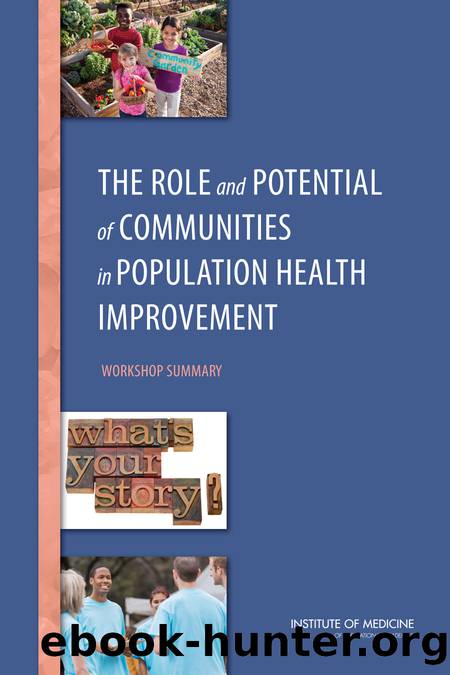The Role and Potential of Communities in Population Health Improvement: Workshop Summary by Theresa Wizemann

Author:Theresa Wizemann
Language: eng
Format: epub
Publisher: The National Academies Press
Published: 2015-03-03T00:00:00+00:00
FIGURE 4-1 ISAIAHâs approach to community organizing.
SOURCES: Hill presentation, April 10, 2014, and HIP, 2013.
Minnesota has a program called The Choice Is Yours, which is an open-enrollment program that allows inner-city, low-income students to attend suburban schools. In order to participate in open enrollment, students must live in Minneapolis and qualify for the free or reduced-price lunch program. The problem, Hill said, is that choice is limited by access. Families with more financial and transportation resources or more time available outside of work, for example, have more choices than families who do not have these resources. Hill added that because of disparities in income, wealth, employment, and other resources that are correlated with race, access to school choice has become racialized.6
Minnesota has an integration revenue funding stream of about $108 million per year. The funding was intended to help schools with integration efforts, Hill said, but because schools were strapped for funding, it was being used as discretionary money. The state House and Senate decided that since the funding was not being used for its intended purpose and because there was a huge education gap in Minnesota, the money should be repurposed. The state formed a 12-member Integration Revenue Replacement Task Force, which met in 2012 to develop recommendations to improve integration funding mechanisms. ISAIAH and other organizations called for communities of color to be at the table to raise the issues of equity and disparities and to begin to redefine integration, both in the classroom and in society. The ISAIAH Education and Health Committees monitored the process, and ISAIAH decided that a health impact assessment would be an effective tool with which to begin to build the narrative to address the harsh realities of integration and equity in Minnesota.
Rapid Health Impact Assessment of School Integration Strategies in Minnesota
The health impact assessment (HIA), conducted jointly by ISAIAH and Human Impact Partners, focused on the recommendations drafted by the state task force and on the potential health effects of the associated state legislation.7 The process and outcome were equally important, Hill said. The goal was to have a diverse group of people at the table who understood equity, power, and community agency and who would ask questions. Redefining integration and school choice would involve understanding racial wounds, forging new understanding and meaning, and creating a new narrative for integration and opportunity. Hill emphasized that it was essential that the research be co-owned and created by the stakeholders.
The HIA was completed in three months so that the results could be used to inform the legislation that would be based on the state task forceâs recommendations. This rapid timeline was possible, in part, because the relationships ISAIAH established over time allowed for timely organization. A 12-member stakeholder panel that convened to guide the HIA included ISAIAH members, teachers, a school district administrator, a school board member, parents, academic researchers, racial justice advocates, and a member of the state Integration Revenue Replacement Task Force. In response to a question, Hill noted that even though there was diversity on the panel, not all groups were represented.
Download
This site does not store any files on its server. We only index and link to content provided by other sites. Please contact the content providers to delete copyright contents if any and email us, we'll remove relevant links or contents immediately.
Introduction to Social Work Practice : A Practical Workbook by Herschel Knapp(285)
Selective Oxidation Catalysts Obtained by the Immobilization of Iron (III) Porphyrins on Layered Hydroxide Salts by Fernando Wypych Shirley Nakagaki & Guilherme Sippel Machado(276)
How Data Happened by Unknown(267)
Global Health Governance and Commercialisation of Public Health in India by Anuj Kapilashrami Rama V. Baru(220)
Unmasked by Emily Mendenhall(183)
Curing Cancerphobia by David Ropeik(174)
The Pandemic Divide by Gwendolyn L. Wright Lucas Hubbard and William A. Darity Jr(160)
Feminist Global Health Security by Clare Wenham(149)
Restoring Quality Health Care by Scott W. Atlas(147)
FALSE PANDEMICS: ARGUMENTS AGAINST THE RULE OF FEAR by Wolfgang Wodarg(147)
Transforming Health Care Scheduling and Access: Getting to Now by Gary Kaplan(143)
Oversight and Review of Clinical Gene Transfer Protocols: Assessing the Role of the Recombinant DNA Advisory Committee by Rebecca N. Koehler(141)
The Making of a Pandemic: Social, Political, and Psychological Perspectives on Covid-19 by John Ehrenreich(140)
Pandemic India by Arnold David;(139)
The Metropolitan Academic Medical Center by David E. Rogers Eli Ginzberg(128)
Insane Society: A Sociology of Mental Health by Peter Morrall(128)
Into Africa, Out of Academia by Kwan Kew Lai(127)
Risk Communication and Infectious Diseases in an Age of Digital Media by Anat Gesser-Edelsburg Yaffa Shir-Raz(126)
Psychosocial Interventions for Mental and Substance Use Disorders: A Framework for Establishing Evidence-Based Standards by Mary Jane England(126)
